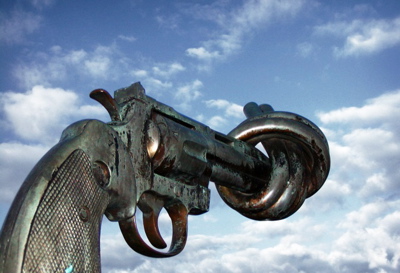The Institutionalization of Nonviolence
by Beverly Woodward

Nonviolence sculpture by Carl Fredrik Reuterswärd; courtesy en.wikipedia.org
Editor’s Preface: This unpublished essay was presented at an international conference of peace researchers and activists (July 1-6, 1975, Noordwijkerhout, Netherlands), and continues our series of rediscoveries from the War Resisters’ International archive. For further notes on the text, the archival reference and a biographical note about Woodward please see the end. JG
The term “nonviolence” has been a controversial one. Over the years many have objected to it on the grounds that it is negative rather than positive in substance and therefore does not hold out a vision of what one is for rather than what one is against. The objection is valid, but it overlooks one benefit obtained by the use of this term. When we speak of nonviolence we highlight the fact that a peaceful world cannot be attained without struggle and resistance. Nonviolence is anti-violence and must be, since violence, unfortunately, is woven into the fabric of our lives. To obtain peace we must resist violence. To resist violence is to resist deeply rooted inclinations, habits, customs, laws, and institutions.
Resistance, of course, is not all that there is to nonviolence, but it is a very important aspect and any glossing over of that fact only leads to misunderstandings. Evidence of such misunderstandings was provided by some of the more common reactions to the largely nonviolent, but often disruptive activities of the anti-war movement in the nineteen sixties and early seventies. Peace and placidity have a way of getting equated and it then is assumed that activity that disturbs or disrupts is antithetical to peace, just as it is often mistakenly assumed that aggressive activity is necessarily destructive or violent.
One definition of “placid” is “complacent”. Complacency, however, is precisely what is not in order as long as we live in a society and in a world permeated by human destructiveness. Most nonviolent resistance can be seen as an effort to overcome one or another form of complacency and to do so without destroying human life. Since the status quo is often felt to be even more sacred than human life, nonviolent action may be experienced as more threatening than the threat of murder. When Gandhi challenged race laws in South Africa and caste laws and customs in India, he sent shock waves through those nations. Yet had he been a soldier in the army, even a general, whose mission was to defend the existing order, he would not have had the same impact on his opponents. For he and his opponents would have had several things in common: the belief in the need to defend the existing order in their respective countries (along with a willingness to disrupt the given order elsewhere), the belief that violence is an acceptable means of defense and that for the most part means can be justified by ends, the belief that violence is necessarily a part of politics. Gandhi sent shock waves through the societies he inhabited both because he challenged the status quo and because his manner and methods in posing this challenge were unorthodox.
Read the pdf of the complete article here: The Institutionalization of Nonviolence
Reference: IISG/WRI Archive Box 72: Folder 2, Subfolder 1. We are grateful to WRI/London and their director Christine Schweitzer for their cooperation in our WRI project.
A NOTE ON THE TEXT: Besides the presentation at Noordwijkerhout mentioned in the Editor’s Preface, the paper was also delivered some months earlier (April 2, 1975) at the conference, “Perspectives on American Violence and Aggression”, sponsored by the College of Liberal Arts, Clemson University, Clemson, South Carolina.
EDITOR’S NOTE: Beverly Woodward was a long serving member of War Resisters’ League (USA), and authored or co-authored many pamphlets and tracts about pacifism, including, with Michael Randle, Militarism and Repression, Boston: International Seminars for Training for Nonviolent Action, 1980.




